Vimar 01796.2 Handleiding
Vimar
Niet gecategoriseerd
01796.2
Bekijk gratis de handleiding van Vimar 01796.2 (4 pagina’s), behorend tot de categorie Niet gecategoriseerd. Deze gids werd als nuttig beoordeeld door 80 mensen en kreeg gemiddeld 4.5 sterren uit 40.5 reviews. Heb je een vraag over Vimar 01796.2 of wil je andere gebruikers van dit product iets vragen? Stel een vraag
Pagina 1/4

Viale Vicenza, 14
36063 Marostica VI - Italy
www.vimar.com
49401448A0 03 2206
01796.2
SMART SWITCH
Attuatore EnOcean multifunzione con uscita a relè NO 10 A 230 V~ program-
mabile con funzione interruttore per comando locale, ingresso locale trasferi-
bile come comando ON/OFF verso altri attuatori EnOcean, alimentazione 230
V~ 50 Hz.
L’attuatore con modulo EnOcean è in grado di ricevere il comando radio del tasto basculante
radiofrequenza per attuare, mediante l’uscita a relè, il carico al quale esso è collegato. Può essere
inoltre collegato ad un interruttore per comandare il carico anche da locale oppure ad una presa
di corrente per accendere/spegnere mediante il comando radio il carico ad essa collegato. Grazie
alle sue dimensioni ridotte, l’attuatore può essere installato ovunque sulla parete (da retrofrutto
all’interno della scatola da incasso) o sul soffitto (controsoffitto, ecc.).
Nel caso di mancanza di alimentazione da rete, l’attuatore mantiene la configurazione pre-
cedentemente effettuata.
CARATTERISTICHE TECNICHE.
• Alimentazione: 230 V~, 50 Hz.
• Capacità di commutazione: 230 V~ - 10 A
• Autoconsumo: <1W
• Range di frequenza: 868.3 MHz
• Banda di frequenza occupata: da 868,0 a 868,6 Mhz
• Potenza RF Max: +3dBm
• Portata: fino a 30 metri
• Temperatura di funzionamento: 0 - 35 °C
• Numero massimo di trasmettitori radio memorizzabili: 24
• Led RGB per la segnalazione delle varie fasi di configurazione
• EEP (Profile EnOcean®): D2-01-0F
• Dimensioni: 40 mmx 44 mmx 16.9 mm
• Peso: 34 g
CARICHI COMANDABILI.
• Uscita a relè con i seguenti carichi comandabili:
- carichi resistivi : 10 A (20.000 cicli);
- lampade a incandescenza : 5 A (20.000 cicli);
- lampade fluorescenti : 58 W (5.000 cicli);
- lampade a LED : 100 W-230 V~ (20.000 cicli);
- trasformatori elettronici : 4 A (20.000 cicli);
- motori cos ø 0,6: 3,5 A (100.000 cicli).
INSTALLAZIONE.
• Installazione 1 interruttore e 1 lampada. Di default tutti gli interruttori cablati connessi al
all’attuatore funzionano come «commutatore» («interruttore bidirezionale») con trasmettitori
EnOcean® associati al dispositivo.
Nota: C e NO sono i contatti del relè liberi da potenziale.
• Identificazione della configurazione dell’interruttore. Quando si alimenta l’attuatore dopo averlo
configurato, premere una sola volta l’interruttore al quale è connesso. Verrà eseguita una procedura
di identificazione automatica per individuare se si utilizza un interruttore monostabile o bistabile.
Nota Non : La stessa configurazione viene applicata sia per l’interruttore 1 che per l’interruttore 2.
è possibile collegare due tipi diversi di interruttore collegati ad un unico attuatore 01796.2. Per
effettuare un nuova identificazione automatica è necessario resettare manualmente il dispositivo.
CONFIGURAZIONE.
MODALITÀ DI FUNZIONAMENTO DELL’ATTUATORE
• COMANDO LOCALE. È possibile accendere o spegnere localmente il dispositivo premendo
brevemente il pulsante CONF. Questo determina la commutazione contemporanea dell’uscita.
• ASSOCIAZIONE. Sono disponibili due procedure (1 o 2) per accedere alla modalità di
associazione:
1. Premere 3 volte il pulsante CONF; il LED si accende di rosso per indicare che dispositivo è in
«Modalità di associazione». Premendo di nuovo CONF si esce dalla «Modalità di associazione».
2. Se gli interruttori sono collegati su P1 e/o P2 eseguire una “tripla pressione” su uno qualsiasi
degli interruttori per i quali si desidera attivare la «Modalità di associazione». Si tenga presente
che P1 comanda l’uscita NO mentre P2 non comanda alcuna uscita.
Quando l’attuatore si trova in «Modalità di associazione» commuta l’accensione/spegnimento
dell’uscita ogni 1 s.
Per associare un trasmettitore, si veda il paragrafo Procedura di associazione come ricevitore;
il LED si accende di verde per confermare la procedura di associazione. Se durante la «Modalità
di associazione» il LED lampeggia in arancione significa che la memoria dell’attuatore è piena
oppure che, nel corso della procedura, non è stato associato alcun trasmettitore. In caso di
memoria piena cancellare un trasmettitore e quindi associare quello nuovo.
• SEGNALAZIONI DEL LED DURANTE LA “MODALITÀ DI APPRENDIMENTO”.
FASI «Modalità di apprendimento» SEGNALAZIONE dei LED
Accesso alla «Modalità apprendimento» 1 lampeggio e poi si accende VERDE
ROSSO
Dispositivo arruolato 2 lampeggi VERDE
Cancellazione dispositivo arruolato 2 lampeggi ROSSO
Interruzione della «Modalità apprendimento» 2 lampeggi ROSSO
Errore durante la «Modalità apprendimento» 2 lampeggi ROSSO
Memoria piena (superati i 24 dispositivi) 2 lampeggi ARANCIONE
Timeout della «Modalità apprendimento» 2 lampeggi ARANCIONE
• RESET DEL DISPOSITIVO. Premere CONF per più di 5 s fino a quando il LED si accende di
arancione; quando si rilascia il pulsante il LED rimane acceso e si è in «Modalità Reset». Premere
una volta CONF per effettuare il reset; il LED lampeggia in rosso e verde per confermare l’ope-
razione. Nella «Modalità Reset» il pulsante deve essere premuto entro 30 s al termine dei quali,
se non viene effettuata nessuna operazione, il LED smette di lampeggiare e non viene eseguito
alcun reset.
PROCEDURA DI ASSOCIAZIONE COME RICEVITORE.
• Interruttore EnOcean® Type “comando a pulsanti basculanti” (EEP: F6-02-01).
Per associare questo il trasmettitore all’attuatore effettuare quanto segue:
1. Attivare la « Modalità di associazione » del dispositivo.
2. Premere un tasto qualsiasi del comando radio. Il tasto premuto durante il processo di
associazione è quello che attiva il canale selezionato mentre l’altro tasto spegne il canale
selezionato. Ad esempio:
Modalità di
associazione Uso
Tasto associato
durante la
“Modalità di
associazione”
Tasto premuto
sul trasmettitore
Stato attuatore
01796.2
ON
OFF
ON
OFF
ON
OFF
ON
OFF
Per eliminare l’associazione di un trasmettitore attivare la «Modalità di associazione» e premere
un tasto qualsiasi del trasmettitore. Il dispositivo non potrà più controllare il canale selezionato
dell’attuatore 01796.2.
PROCEDURA DI ASSOCIAZIONE COME TRASMETTITORE
Quando gli interruttori sono collegati agli ingressi P1 e/o P2 possono funzionare da trasmettitori
EnOcean®; una volta configurati infatti, attraverso l’attuatore 01796.2, possono comandare
qualsiasi altro ricevitore compatibile EnOcean®.
Per associare l’attuatore 01796.2 ad un altro ricevitore procedere come segue:
1. Attivare la «Modalità di associazione» del ricevitore.
2. Premere una volta il tasto dell’interruttore collegato che si vuole associare al ricevitore.
Al termine della procedura di associazione, lo stato (ON oppure OFF) dell’uscita dell’attuatore
01796.2 determina lo stato di «ON» del ricevitore associato.
Esempio.
Se si desidera che il ricevitore sia sincronizzato con l’attuatore, associare il tasto portando l’uscita
su ON; viceversa, se si desidera che il ricevitore non sia sincronizzato, associare il tasto portando
l’uscita su OFF.
Per eliminare l’associazione dell’attuatore 01796.2 da un altro ricevitore attivare la «Modalità di
associazione » del ricevitore e premere una volta il tasto dell’interruttore associato al ricevitore.
PROFILI SUPPORTATI (EEP)
F6-02-01 F6-04-01 F6-10-00 D5-00-01 A5-07-01
A5-07-02 A5-07-03 A5-08-01 A5-08-02 A5-08-03
A5-10-19 A5-10-18 A5-10-1A A5-10-1B A5-10-1C
A5-10-1D A5-10-01 A5-10-05 A5-10-08 A5-10-0C
A5-10-10 A5-10-13 A5-10-17 A5-10-0AA5-10-16
A5-10-0B A5-14-02 A5-14-03 A5-14-04 A5-14-01
REGOLE DI INSTALLAZIONE.
• L’installazione deve essere effettuata da personale qualificato con l’osservanza delle disposizioni
regolanti l’installazione del materiale elettrico in vigore nel paese dove i prodotti sono installati.
• Durante l’installazione del prodotto la tensione di alimentazione DEVE ESSERE SCOLLEGATA.
Eseguire la disconnessione direttamente dall’interruttore generale.
• Si tenga presente che il LED sarà sempre di colore verde quando il dispositivo è acceso.
Assicurarsi di togliere la tensione di alimentazione (LED verde spento) prima di apportare qualsiasi
modifica ai collegamenti.
CONFORMITÀ NORMATIVA.
Direttiv . a RED Norme EN 60669-2-1, EN 300 220-2, EN 301 489-3, EN 62479.
Vimar SpA dichiara che l’apparecchiatura radio è conforme alla direttiva 2014/53/UE. Il testo
completo della dichiarazione di conformità UE è disponibile nella scheda di prodotto al seguente
indirizzo Internet: www.vimar.com.
Regolamento REACh (UE) n. 1907/2006 – art.33. Il prodotto potrebbe contenere tracce di piombo.
A
B

Viale Vicenza, 14
36063 Marostica VI - Italy
www.vimar.com
49401448A0 03 2206
01796.2
SMART SWITCH
EnOcean multi-function actuator with relay output NO 10 A 230 V~ program-
mable with switch function for local control, transferable local input as ON/
OFF control for other EnOcean actuators, 230 V~ 50 Hz power supply.
The actuator with EnOcean module is able to receive the radio command from the radio
frequency rocker button to actuate the connected load via the relay output. It can also be
connected to a switch to control the local also locally or to a socket outlet to switch the load
on/off via the radio control. With its compact dimensions, the actuator can be installed anywhere
on the wall (behind the insert in the flush mounting box) or on the ceiling (false ceiling, etc.).
If there is no mains power supply, the actuator keeps the previous configuration.
TECHNICAL CHARACTERISTICS.
• Power supply: 230 V~, 50 Hz.
• Switching capacity: 230 V~ - 10 A
• Self-consumption: <1W
• Frequency range: 868.3 MHz
• Frequency band occupied: from 868.0 to 868.6 Mhz
• Max. RF power: +3dBm
• Range: up to 30 metres
• Operating temperature: 0 - 35 °C
• Maximum number of radio transmitters that can be stored: 24
• RGB LED for signalling the various configuration phases
• EEP (Profile EnOcean®): D2-01-0F
• Dimensions: 40 mm x 44 mm x 16.9 mm
• Weight: 34 g
CONTROLLABLE LOADS.
• Relay output with the following controllable loads:
- resistive loads : 10 A (20.000 cycles);
- incandescent lamps : 5 A (20.000 cycles);
- fluorescent lamps : 58 W (5.000 cycles);
- LED lamps : 100 W-230 V~ (20.000 cycles);
- electronic transformers : 4 A (20.000 cycles);
- cos ø 0.6 motors: 3.5 A (100,000 cycles).
INSTALLATION.
• Installation 1 switch and 1 lamp. By default all wired switches connected to the actuator work
as “switch” (“two-way switch”) with EnOcean® transmitters associated to the device.
Note: C and NO are relay contacts free from potential.
• Identification of the switch configuration. When powering up the actuator after configuration,
press the switch it is connected to only once. An automatic identification procedure will be run
to identify if a one-position stable or two-position stable switch is being used.
Note: The same configuration applies to both switch 1 and switch 2. It is not possible to
connect two different types of switch connected to a single actuator 01796.2. To run the
automatic identification again manually reset the device.
CONFIGURATION.
ACTUATOR OPERATING MODES
• LOCAL CONTROL. It is possible to switch the device on or off locally with a short press of the
CONF button. This switches the output at the same time.
• ASSOCATION. Two procedures (1 or 2) are available to access the association mode:
1. Press the CONF button 3 times; the LED turns on, red, to indicate that the device is in
“Association mode”. Press CONF again to exit the “Association mode”.
2. If the switches are connected on P1 and/or P2 press any of the switches for which you wish
to activate the “Association mode” three times. Consider that P1 controls the NO output
while P2 doesn't control any output.
When the actuator is in “Association mode” switches output on/off every 1 s.
To associate a transmitter, see paragraph Procedure for association as receiver; the LED
lights up in green to confirm the association procedure. If during the “Association mode” the
LED flashes orange it means that the actuator memory is full or that, during the procedure, no
transmitter has been associated. If the memory is full delete a transmitter and then associate
the new one.
• LED INDICATIONS DURING “LEARNING MODE”.
“Learning mode” PHASES LED INDICATORS
Access to “Learning mode” flash then turns to 1 GREEN RED
Device enrolled flashes2 GREEN
Deletion of enrolled device 2 RED flashes
Interruption of “Learning mode” 2 RED flashes
Error during “Learning mode” 2 RED flashes
Memory full (24 devices exceeded) 2 ORANGE flashes
“Learning mode” time-out 2 ORANGE flashes
• DEVICE RESET. Press CONF for more than 5 s until the LED turn on orange; when the
button is released the LED remains on and you are in “Reset Mode”. Press CONF once to
reset; the LED flashes red and green to confirm the operation. In “Reset Mode” the button
must be pressed within 30 s after which, if no operations are performed, the LED stops
flashing and no reset is run.
PROCEDURE FOR ASSOCIATION AS RECEIVER.
• EnOcean® Switch, Type “rocker button control” (EEP: F6-02-01).
To associate this transmitter to the actuator proceed as follows:
1. Activate the “Association mode” on the device.
2. Press any button on the radio control. The button pressed during the association process
is the one that activates the selected channel while the other button switches off the selected
channel. For example:
Association
mode Use
Associated button
during the
“Association
mode”
Button pressed
on the
transmitter
State of
actuator
01796.2
ON
OFF
ON
OFF
ON
OFF
ON
OFF
To delete the association of a transmitter activate the “Association mode” and press any
button on the transmitter. The device can no longer control the selected channel on the
actuator 01796.2.
PROCEDURE FOR ASSOCIATION AS TRANSMITTER.
When the switches are connected to inputs P1 and/or P2 they can operate as EnOcean®
transmitters; once configured, via actuator 01796.2, they can control any other EnOcean®-
compatible receiver.
To associate actuator 01796.2 to another receiver proceed as follows:
1. Activate the “Association mode” on the receiver.
2. Press the button on the connected switch to be associated to the receiver once.
At the end of the association procedure, the state (ON or OFF) of the output on actuator
01796.2 determines the “ON” state of the associated receiver.
Example.
If you want the receiver to be synchronised with the actuator, associate the button by moving
the output to ON; vice versa, if you don't want the receiver to be synchronised, associate the
button by switching the output to OFF.
To delete the association of actuator 01796.2 from another receiver activate the “Association
mode” on the receiver and press the button on the switch associated to the receiver once.
SUPPORTED PROFILES (EEP)
F6-02-01 F6-04-01 F6-10-00 D5-00-01 A5-07-01
A5-07-02 A5-07-03 A5-08-01 A5-08-02 A5-08-03
A5-10-19 A5-10-18 A5-10-1A A5-10-1B A5-10-1C
A5-10-1D A5-10-01 A5-10-05 A5-10-08 A5-10-0C
A5-10-10 A5-10-13 A5-10-17 A5-10-0AA5-10-16
A5-10-0B A5-14-02 A5-14-03 A5-14-04 A5-14-01
INSTALLATION RULES.
• Installation must be carried out by qualified persons in compliance with the current regula-
tions regarding the installation of electrical equipment in the country where the products are
installed.
• During product installation the supply voltage MUST BE DISCONNECTED. Disconnect
directly at the main switch.
• Consider that the LED will always be green when the device is on. Remember to switch off
the supply voltage (green LED off) before modifying the connections in any way.
REGULATORY COMPLIANCE.
RED Directive. Standards EN 60669-2-1, EN 300 220-2, EN 301 489-3, EN 62479.
Vimar SpA declares that the radio equipment complies with Directive 2014/53/EU. The full text
of the EU declaration of conformity is on the product sheet available on the following website:
www.vimar.com
REACH (EU) Regulation no. 1907/2006 – Art.33. The product may contain traces of lead.
A
B

Viale Vicenza, 14
36063 Marostica VI - Italy
www.vimar.com
49401448A0 03 2206
01796.2
SMART SWITCH
Actionneur EnOcean multifunzione avec sortie à relais NO 10 A 230 V~ pro-
grammable avec fonction interrupteur pour commande locale, entrée locale
transférable comme commande ON/OFF vers d’autres actionneurs EnOcean,
alimentation 230 V~ 50 Hz.
L’actionneur avec module EnOcean est en mesure de recevoir la commande radio de la touche
va-et-vient fréquence radio pour actionner, par le biais de la sortie à relais, la charge à laquelle il
est relié. Il peut également être branché à un interrupteur pour commander la charge localement
ou bien à une prise électrique pour allumer/éteindre, au moyen de la commande radio, la charge
y étant reliée. Grâce à ses dimensions réduites, l’actionneur peut être installé en tous points sur
le mur (derrière le socle dans la boîte d’encastrement) ou au plafond (faux plafond, etc.). Pendant
les pannes d'électricité sur le réseau, l'actionneur conserve la configuration précédente.
CARACTÉRISTIQUES TECHNIQUES
• Alimentation: 230 V~, 50 Hz.
• Capacité de commutation: 230 V~ - 10 A
• Autoconsommation: <1 W
• Gamme de fréquence: 868.3 MHz
• Bande de fréquence occupée: de 868,0 à 868,6 Mhz
• Puissance RF max.: +3 dBm
• Portée: jusqu’à 30 mètres
• Température de fonctionnement: 0- 35°C
• Nombre maximum d’émetteurs radio mémorisables: 24
• Led RGB pour la signalisation des différentes phases de configuration
• EEP (Profile EnOcean®): D2-01-0F
• Dimensions: 40 mmx 44 mmx 16,9 mm
• Poids: 34 g
CHARGES PILOTABLES.
• Sortie à relais avec les charges pilotables suivantes:
- charges résistives : 10 A (20.000 cycles);
- lampes à incandescence : 5 A (20.000 cycles);
- lampes fluorescentes : 58 W (5.000 cycles);
- lampes LED : 100 W-230 V~ (20.000 cycles);
- transformateurs électroniques : 4 A (20.000 cycles);
- moteurs cos ø 0,6 : 3,5 A (100000 cycles).
INSTALLATION
• Installation 1 interrupteur et 1 lampe. Tous les interrupteurs câblés et connectés à l’actionneur
fonctionnent par défaut comme « commutateur » (« interrupteur bidirectionnel ») avec transmetteurs
EnOcean® associés au dispositif. : C et NO sont les contacts du relais libres de potentiel.Remarque
• Identification de la configuration de l’interrupteur. Lors de l’alimentation de l’actionneur,
après l’avoir configuré, n’appuyer qu’une seule fois sur l’interrupteur auquel il est connecté.
L’exécution de la procédure d’identification automatique permettra d’établir si l’interrupteur utilisé
est monostable ou bi-stable.
Remarque: cette même configuration est appliquée aussi bien à l’interrupteur 1 qu’à l’interrupteur
2. Il est impossible de connecter deux types différents d’interrupteur à un seul actionneur
01796.2. Pour effectuer une nouvelle identification automatique, il est nécessaire de réinitialiser le
dispositif manuellement.
CONFIGURATION.
MODALITÉ DE FONCTIONNEMENT DE L'ACTIONNEUR
• COMMANDE LOCALE. Il est possible d’allumer ou d’éteindre localement le dispositif en
appuyant brièvement sur le bouton CONF. Il y a ainsi commutation simultanée de la sortie.
• ASSOCIATION. Il existe deux procédures (1 ou 2) pour accéder à la modalité d’association :
1. Appuyer 3 fois sur le bouton CONF ; la LED s’allume en rouge pour indiquer que le dispositif
est en « Modalité d’association ». Appuyer de nouveau sur CONF pour sortir de la « Modalité
d’association ».
2. Si les interrupteurs sont raccordés à P1 et/ou P2, effectuer une « triple pression » sur l'un des
interrupteurs pour lesquels activer la « Modalité d’association ». À noter que P1 commande la
sortie NO alors que P2 ne commande aucune sortie.
Lorsque l’actionneur est en « Modalité d’association », il commute l’allumage/extinction de la
sortie toutes les 1 s.
Pour associer un transmetteur, voir le paragraphe Procédure d’association comme récepteur;
la LED s’allume en vert pour confirmer la procédure d’association. Lorsque la LED clignote en
orange pendant la « Modalité d’association », elle indique que la mémoire de l'actionneur est
pleine ou qu'aucun transmetteur n'a été associé pendant la procédure. Si la mémoire est pleine,
éliminer un transmetteur et associer le nouveau.
• SIGNALISATIONS DE LA LED DURANT LA « MODALITÉ D’APPRENTISSAGE ».
PHASES « Modalité d’apprentissage » SIGNALISATION des LEDS
Accès à la « Modalité apprentissage » 1 clignotement en puis allumage VERT
permanent ROUGE
Dispositif associé 2 clignotements en VERT
Élimination dispositif associé 2 clignotements en ROUGE
Interruption de la « Modalité apprentissage » 2 clignotements en ROUGE
Erreur durant la « Modalité apprentissage » 2 clignotements en ROUGE
Mémoire pleine (au bout de 24 dispositifs) 2 clignotements en ORANGE
Délai d’attente de la « Modalité apprentissage » 2 clignotements en ORANGE
• RÉINITIALISATION DU DISPOSITIF. Appuyer sur CONF pendant plus de 5 s jusqu'à ce que
la LED s'allume en orange; au relâchement du bouton, la LED reste allumée et l’on entre en
« Modalité Réinitialisation ». Appuyer une fois sur CONF pour réinitialiser ; la led clignote en
rouge et vert pour confirmer l’opération. En « Modalité Réinitialisation », le bouton doit toujours
être enfoncé dans les 30 secondes. Si aucune opération n'est effectuée au bout de ces 30
secondes, la LED cesse de clignoter et aucune réinitialisation n’a lieu.
PROCÉDURE D’ASSOCIATION COMME RÉCEPTEUR
• Interrupteur EnOcean® Type « commande à boutons va-et-vient » (EEP : F6-02-01).
Pour associer le transmetteur à l’actionneur, effectuer ce qui suit:
1. Activer la « Modalité d’association » du dispositif.
2. Appuyer sur une touche quelconque de la commande radio. La touche enfoncée pendant le
processus d'association est celle qui active le canal sélectionné tandis que l'autre touche éteint
le canal sélectionné. Par exemple:
Modalité
d’association Utilisation
Touche associée
durant la
« Modalité
d’association »
Touche
enfoncée
sur le
transmetteur
État
actionneur
01796.2
ON
OFF
ON
OFF
ON
OFF
ON
OFF
Pour éliminer l’association d’un transmetteur, activer la « Modalité d’association » et appuyer
sur une touche quelconque du transmetteur. Le dispositif ne pourra plus contrôler le canal
sélectionné de l'actionneur 01796.2.
PROCÉDURE D'ASSOCIATION COMME TRANSMETTEUR
Lorsque les interrupteurs sont connectés aux entrées P1 et/ou P2, ils peuvent fonctionner comme
transmetteurs EnOcean® ; une fois configurés, ils peuvent e effet commander tout autre récepteur
compatible EnOcean® via l'actionneur 01796.2.
Pour associer l’actionneur 01796.2 à un autre récepteur, procéder comme suit :
1. Activer la « Modalité d’association » du récepteur.
2. Appuyer une fois sur la touche de l’interrupteur raccordé à associer au récepteur.
Au terme de la procédure d’association, l’état (ON ou bien OFF) de la sortie de l’actionneur
01796.2 détermine l’état « ON » du récepteur associé.
Exemple.
Pour que le récepteur soit synchronisé avec l'actionneur, associer la touche en mettant la sortie
sur ON; inversement, pour que le récepteur ne soit pas synchronisé, associer la touche en mettant
la sortie sur OFF.
Pour éliminer l’association de l'actionneur 01796.2 d'un autre récepteur, activer la « Modalité
d’association » du récepteur et appuyer une fois sur la touche de l’interrupteur associé au
récepteur.
PROFILS SUPPORTÉS (EEP)
F6-02-01 F6-04-01 F6-10-00 D5-00-01 A5-07-01
A5-07-02 A5-07-03 A5-08-01 A5-08-02 A5-08-03
A5-10-19 A5-10-18 A5-10-1A A5-10-1B A5-10-1C
A5-10-1D A5-10-01 A5-10-05 A5-10-08 A5-10-0C
A5-10-10 A5-10-13 A5-10-16 A5-10-17 A5-10-0A
A5-10-0B A5-14-02 A5-14-03 A5-14-04 A5-14-01
CONSIGNES D'INSTALLATION
• L'installation doit être effectuée par un personnel qualifié et en conformité avec la réglemen-
tation en vigueur en matière d’installation du matériel électrique dans le pays où les produits
sont installés.
• Lors de l'installation du produit, la tension d'alimentation DOIT ÊTRE DÉCONNECTÉE.
Déconnecter directement au moyen de l’interrupteur général.
• À noter que la LED sera toujours verte lorsque le dispositif est allumé. S’assurer de mettre hors
tension (LED verte éteinte) avant de modifier les branchements.
CONFORMITÉ AUX NORMES.
Directive RED. Normes EN 60669-2-1, EN 300 220-2, EN 301 489-3, EN 62479.
Vimar SpA déclare que l'équipement radio est conforme à la directive 2014/53/UE. Le texte com-
plet de la déclaration de conformité UE est disponible sur la fiche du produit à l'adresse Internet
suivante: www.vimar.com.
Règlement REACH (EU) n° 1907/2006 – art.33. Le produit pourrait contenir des traces de plomb.
A
B
Product specificaties
| Merk: | Vimar |
| Categorie: | Niet gecategoriseerd |
| Model: | 01796.2 |
Heb je hulp nodig?
Als je hulp nodig hebt met Vimar 01796.2 stel dan hieronder een vraag en andere gebruikers zullen je antwoorden
Handleiding Niet gecategoriseerd Vimar
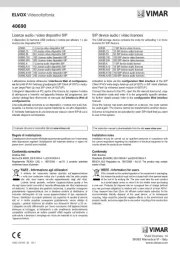
2 September 2025
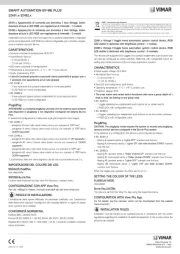
26 Augustus 2025
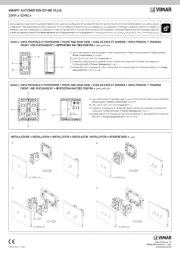
26 Augustus 2025
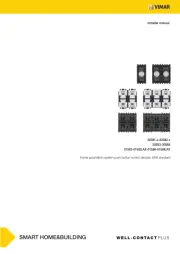
26 Augustus 2025
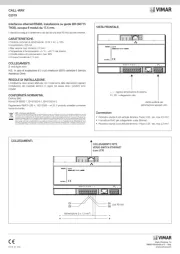
14 Augustus 2025
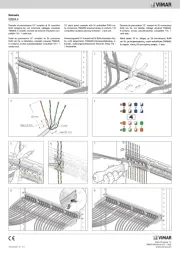
5 Juli 2025
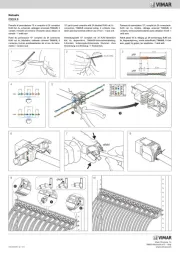
5 Juli 2025
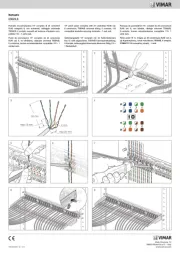
5 Juli 2025

5 Juli 2025
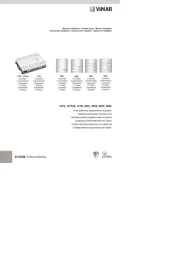
24 Mei 2025
Handleiding Niet gecategoriseerd
- Telefunken
- Kontakt Chemie
- Meec Tools
- Ark
- Jahnke
- Huawei
- Twisper
- Safescan
- IODD
- PreSonus
- Daitsu
- Neve
- Xuma
- Meinl
- Peerless
Nieuwste handleidingen voor Niet gecategoriseerd

14 September 2025

14 September 2025

13 September 2025

13 September 2025

13 September 2025

13 September 2025

13 September 2025

13 September 2025

13 September 2025

13 September 2025